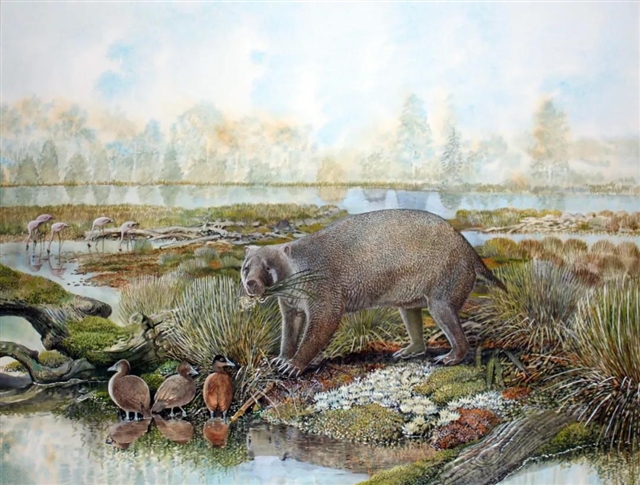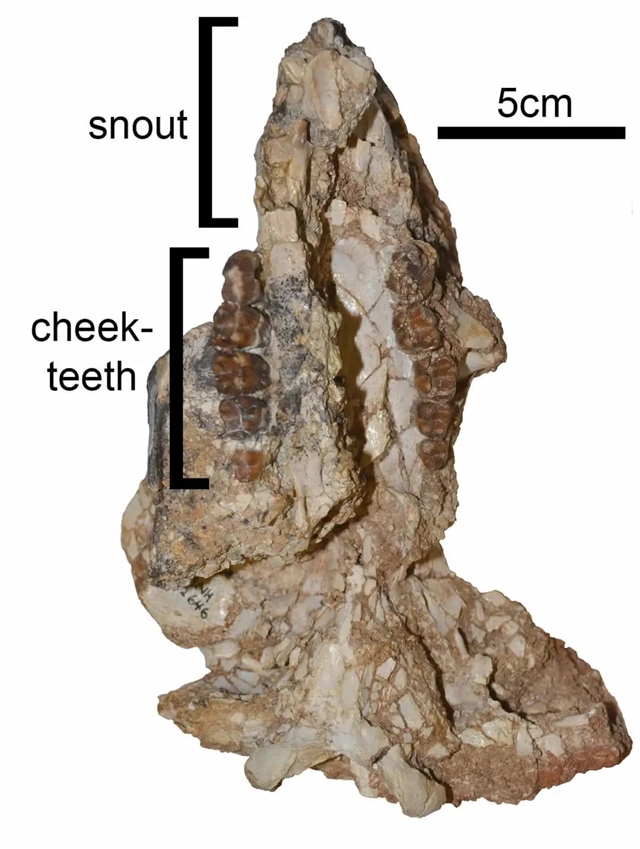|
|
|
|
|
大型有袋类动物揭示袋熊掘洞行为的演化 |《科学报告》论文 |
|
|
论文标题:A new family of diprotodontian marsupials from the latest Oligocene of Australia and the evolution of wombats, koalas, and their relatives (Vombatiformes)
期刊:Scientific Reports
作者:Robin M. D. Beck, Julien Louys et.al
发表时间:2020/06/25
数字识别码:10.1038/s41598-020-66425-8
微信链接:点击此处阅读微信文章
本周《科学报告》发表的一篇论文A new family of diprotodontian marsupials from the latest oligocene of Australia and the evolution of wombats, koalas, and their relatives (Vombatiformes)报告了一种古代有袋类动物的新种——Mukupirna nambensis,它代表了迄今为止已知发掘的最古老的澳大利亚有袋类动物之一,其解剖特征有助于我们进一步理解现代袋熊的演化及其典型的掘洞行为。

2500万年前新物种Mukupirna nambensis的复原图,
图中还有同一地点发掘到的硬尾鸭和火烈鸟。
作者Peter Schouten.
英国索尔福德大学的Robin Beck等人描述了在南澳大利亚艾尔湖盆地(Lake Eyre BaNsin)发掘的一块头骨和部分骨架。该化石可追溯至渐新世晚期(约2500万-2600万年前),属于袋熊亚目的一个新种。袋熊亚目曾是多样性最丰富的有袋类动物演化组之一,目前只剩袋熊科中的三个物种和考拉仍存活着。作者将此次新发现的物种命名为“Mukupirna nambensis”,源自艾尔湖和弗罗姆湖(Lake Frome)周边地区所讲的迪埃里语(Dieri)和马利扬加帕语(Malyangapa)中的“muku”(骨头)和“pirna”(大);其体重估计为143-171千克,约为现存袋熊物种的5倍。

新物种的头骨化石照片,头骨前侧在图片上方,全长19.7厘米。
图片来自格里菲斯大学Julien Louys和索尔福德大学Robin Beck
根据骨骼鉴定出来的一些解剖特征指向了掘洞行为,比如常见于掘洞动物的前臂的适应。但是,先前发掘的可追溯至较晚时期的化石证据表明,Mukupirna对于掘洞行为的适应不如其年代较晚的近亲。这一点以及Mukupirna的体型说明Mukupirna可能不具备现代袋熊所具备的真正的掘洞能力,但是可能通过刮挖的方式,获取地表下面的食物,如植物根茎。现存袋熊物种的另一种典型适应是可以持续生长的专门的臼齿,但是Mukupirna也没有,这表明在袋熊的演化过程中,用于挖掘的骨骼解剖学适应早于牙齿变化。
摘要:We describe the partial cranium and skeleton of a new diprotodontian marsupial from the late Oligocene (~26–25 Ma) Namba Formation of South Australia. This is one of the oldest Australian marsupial fossils known from an associated skeleton and it reveals previously unsuspected morphological diversity within Vombatiformes, the clade that includes wombats (Vombatidae), koalas (Phascolarctidae) and several extinct families. Several aspects of the skull and teeth of the new taxon, which we refer to a new family, are intermediate between members of the fossil family Wynyardiidae and wombats. Its postcranial skeleton exhibits features associated with scratch-digging, but it is unlikely to have been a true burrower. Body mass estimates based on postcranial dimensions range between 143 and 171 kg, suggesting that it was ~5 times larger than living wombats. Phylogenetic analysis based on 79 craniodental and 20 postcranial characters places the new taxon as sister to vombatids, with which it forms the superfamily Vombatoidea as defined here. It suggests that the highly derived vombatids evolved from wynyardiid-like ancestors, and that scratch-digging adaptations evolved in vombatoids prior to the appearance of the ever-growing (hypselodont) molars that are a characteristic feature of all post-Miocene vombatids. Ancestral state reconstructions on our preferred phylogeny suggest that bunolophodont molars are plesiomorphic for vombatiforms, with full lophodonty (characteristic of diprotodontoids) evolving from a selenodont morphology that was retained by phascolarctids and ilariids, and wynyardiids and vombatoids retaining an intermediate selenolophodont condition. There appear to have been at least six independent acquisitions of very large (>100 kg) body size within Vombatiformes, several having already occurred by the late Oligocene.
(来源:科学网)
特别声明:本文转载仅仅是出于传播信息的需要,并不意味着代表本网站观点或证实其内容的真实性;如其他媒体、网站或个人从本网站转载使用,须保留本网站注明的“来源”,并自负版权等法律责任;作者如果不希望被转载或者联系转载稿费等事宜,请与我们接洽。